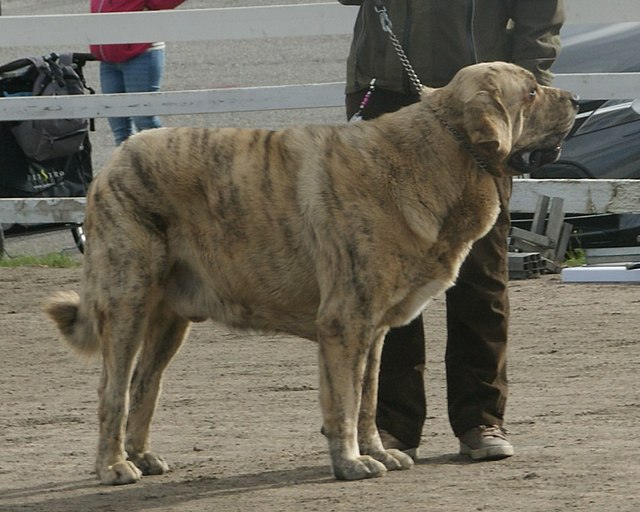


The Spanish Mastiff is a massive, powerful, and gentle giant originally bred for guarding livestock, particularly sheep, in the mountainous regions of Spain. Known for its calm demeanor and loyalty, the breed is often described as affectionate and easygoing despite its imposing size. Spanish Mastiffs are excellent family pets for those with ample space and the ability to meet their exercise needs. They are protective and calm, making them excellent watchdogs. While they may appear intimidating due to their size, they are known for their gentle and patient nature, especially with children and other animals.
The Spanish Mastiff has a long history, dating back to ancient times. It is believed to have descended from large working dogs brought to Spain by the Phoenicians and other ancient cultures. These dogs were used primarily for guarding flocks of sheep and cattle, and their size and strength made them ideal for protecting livestock from predators such as wolves and bears. The breed played a vital role in Spanish farming culture, particularly in the regions of Castile and Leon, where they were used as flock guardians. The Spanish Mastiff’s role as a livestock guardian was particularly important during the transhumance, when shepherds would move their flocks between seasonal pastures. The breed almost disappeared in the 20th century due to industrialization and the decline of traditional farming practices but has seen a resurgence in recent years as a beloved companion dog and livestock guardian.
The Spanish Mastiff is one of the largest dog breeds, with males typically weighing between 110 and 180 pounds (50 to 82 kg) and females weighing between 85 and 130 pounds (39 to 59 kg). They stand between 28 to 35 inches (71 to 89 cm) tall at the shoulder. The breed has a robust and muscular build, with a broad head, large neck, and powerful limbs. Their thick double coat consists of a soft undercoat and a coarser outer coat, which can be short to medium in length. The coat color varies, with common colors including fawn, brindle, and black, often with white markings on the chest, legs, and muzzle. Spanish Mastiffs have a large, square-shaped head with expressive eyes and large, rounded ears that hang close to their head. Their tail is long and thick, and they carry it low, often curled over their back when they are excited or alert.
The Spanish Mastiff is known for its calm, gentle, and patient temperament. Despite its size, the breed is usually very friendly and affectionate with its family members. Spanish Mastiffs are particularly known for their love of children and their ability to be very gentle with them. They are not typically aggressive, although they are naturally protective and will defend their family if they sense a threat. They are very loyal to their owners and can be quite attached to their family, often seeking attention and affection. However, due to their protective nature, they may be reserved or wary around strangers. Early socialization is key to ensuring they are well-adjusted and confident around new people and animals.
Spanish Mastiffs are a relatively low-energy breed compared to other large dogs, and they are not known for being overly active. However, they do require regular exercise to stay healthy and prevent obesity, which can be a concern due to their size. Daily walks and moderate playtime are usually sufficient to meet their exercise needs. While they enjoy outdoor activities, they are not as energetic as other working breeds and are generally content to relax indoors when not actively engaged. Due to their size, it's important to avoid over-exercising young Spanish Mastiffs, as their bones and joints are still developing. Regular, low-impact activities such as leisurely walks or gentle play in a secure yard are recommended for growing puppies.
Spanish Mastiffs are intelligent and eager to please, but their independent and calm nature means they may not always be as driven to perform tasks as other breeds. Training should be consistent and firm, but always based on positive reinforcement methods. These dogs respond well to treats, praise, and affection. Due to their protective nature, early socialization is essential to ensure that they are well-mannered and confident in various situations. Exposing them to different people, environments, and animals will help them develop into well-adjusted dogs. While they are generally calm and patient, they can be stubborn, so training should be approached with patience and consistency. They may be slow to mature, and some dogs may not reach full mental maturity until they are 3 years old.
Spanish Mastiffs are generally a healthy breed, but like all large dogs, they are prone to certain health issues. Common concerns include hip dysplasia, elbow dysplasia, and heart conditions such as dilated cardiomyopathy. Obesity is also a concern, especially as they age, so it's important to monitor their diet and exercise to ensure they maintain a healthy weight. Regular veterinary check-ups are essential to detect any health issues early. Grooming needs are moderate, as the breed's thick coat requires regular brushing to prevent matting and manage shedding. During shedding seasons (spring and fall), they may require more frequent brushing to remove loose hair. They should also have their ears cleaned regularly to prevent infections and their nails trimmed regularly to maintain proper paw health.
The average lifespan of a Spanish Mastiff is between 8 to 12 years. Like many large breeds, they tend to have a shorter lifespan compared to smaller dogs. With proper care, including a healthy diet, regular exercise, and routine veterinary visits, Spanish Mastiffs can live to be relatively old, remaining active and healthy in their later years. Monitoring their weight, avoiding over-exercising young dogs, and providing joint supplements when necessary can help maintain their health and quality of life as they age.
© copyright Dog Compendium 2024 - 2025